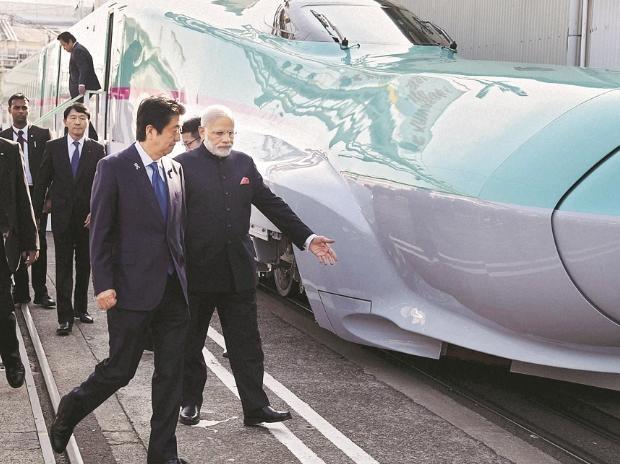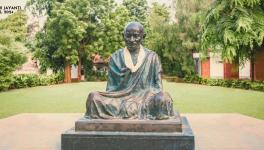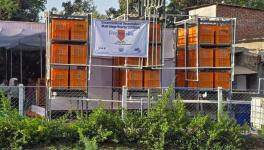Bullet Train Project a "Climate-Negative" Action, 80,000 Trees, Shallow Aquifers to Be Hit: Report

Raising serious environmental concerns over the bullet train project, a coalition of organisations has highlighted that about 80,000 trees of the reserved forests and mangroves would have to be cut down to make way for the high speed corridor.
Terming it as a "clear climate-negative action" on the part of the government, the civil society group has questioned its economic viability, and has sought the rollback of the project. The group has also raised questions about the ridership forecast and the increased interest rate for the heavy loan repayment of the project.
Opposing the land acquisition for the project, these organisations namely Bhumi Adhikar Andolon, Gujarat Khedut Samaj, Kashtakari Sangathana, Maharashtra Rajya Kisan Sabh and National Alliance of People's Movements and Paryavaran Suraksha Samiti have been resisting the bullet train project in different parts of Gujarat and Maharashtra. Questioning the need for the bullet train, National Alliance for People's Movement (NAPM) in a report – Bullet Train: A people's Critique– has highlighted the gaping holes in the feasibility study of Mumbai Ahmedabad High speed Rail (MAHSR). Though the feasibility study conducted by the Railways is quite detailed, but interestingly four key chapters of the report are missing.
The missing chapters (12 to 15) contain details about the project cost, implementation plan, financing options and most importantly economic and financial analysis. These chapters could have shed some light on the calculation of costs and estimated direct/indirect benefits of the project.
NAPM has stated that after repeated attempts to retrieve the missing data through RTI, the concerned authority have simply cited ‘secrecy’ as the revelation apparently might affect business competition. This reason is being used to justify withholding this crucial information from the public.
Quoting the feasibility study, the People's Critique report has stated that the claims of a daily ridership forecast of 40,000 passengers in the year 2023 is ridiculously optimistic if one goes by the present day traffic data used by the study itself. Describing the feasibility study's prediction that from each mode of transport 60 per cent of passengers will switch to the bullet train from the first day of operation is "absurd", said the report, and maintained that the travel demand forecast looks completely unreliable.
It said that though Japan is lending Rs 88,000 crore at an interest rate of 0.1 per cent and the payback period is 50 years with a moratorium of 15 years, the major concern is the relative strength of currencies – Japanese yen and Indian rupee. As a much higher inflation economy than japan, Indian rupee is continuously getting depreciated against the Japanese yen. It is possible that in the 50-year loan repayment period, the loan of Rs 88,000 crore would become three times more than the original loan amount which will put a huge burden on Indian economy, the report suggested.
Flagging the environmental aspect, the report said the proposed route will pass through areas which possibly have shallow aquifers. The digging for the foundations of the supporting pillars is likely to puncture some of these aquifers leading to the loss of groundwater. Large-scale contamination of these aquifers and consequently the ground water sources is also highly likely. This will have a severe impact on the lives of people critically dependent on the source for their daily needs, it said.
The key question is to what extent will the speed enhancement draw the income away from air travel? People's Critique report maintained that the traffic contributed by other modes of transport is even more difficult to convert.
Around 5,000 people travel by trains run by Indian Railways while another 15,000 people travel by personal automobile between Mumbai and Ahmedabad daily, according to the feasibility study. Comparing with other countries, the report has stated that the viability of Indian high speed rail experiment is quite bleak as Taiwan high speed rail had to be shut down because of low ridership – less than half of the predicted ridership.
Quoting the study by the scholars of IIM-Ahmedabad, which showed that 100 daily trips at full occupancy would be required with a fare of Rs 5,000 between Ahmedabad and Mumbai to make the bullet train financially viable, it said across the globe, the transport services do not recover the expenses through fare-box alone.
The report pointed out that apart from the loss of forests along with its biodiversity and water retention contributions, this will also remove the existing carbon sequestration of these many trees. Carbon sequestration is the process involved in carbon capture and the long-term storage of atmospheric carbon dioxide or other forms of carbon to mitigate or defer global warming. The construction phase adds to the pollution and climate-threatening CO2 emissions, as mega projects of these kinds employ massive amounts of energy-intensive machinery and energy-intensive construction practices, which mostly consume heavy diesel oil.
The high speed rail (HSR) corridor is largely a rural area with agriculture and forest lands. During the years of construction, huge amounts of fine dust and grime will adversely affect agriculture and horticulture, contaminate nearby water bodies, and will damage the forest cover. The health of the surrounding population is also under high risk because of likely increase in the level of air pollution. The report has pointed out that even the high-level national transport development policy committee, set up by the government to formulate a long term national transport policy, had recommended that priority should be semi-high speed rail (160-200 kmph) and not HSR.
The proposed Mumbai-Ahmedabad High Speed Rail corridor has 12 stations: Mumbai, Thane, Virar and Boisar in Maharashtra and Vapi, Bilmora, Surat, Bharuch, Vadodara, Anand, Ahmedabad and Sabarmati in Gujarat.
Despite severe resistance against the land acquisition, the preparatory measures are afoot for the 508 km MAHSR project estimated to cost Rs 1.1 lakh crore. The scheduled completion deadline is August 15, 2023.
Talks are on to address the grievances of the land owners and no efforts would be spared to resolve the issue as the land acquisition takes place with consent only, said a senior Railway Ministry official involved with the project.
(Arun Kumar Das is a Delhi-based journalist and can be contacted at [email protected])
Get the latest reports & analysis with people's perspective on Protests, movements & deep analytical videos, discussions of the current affairs in your Telegram app. Subscribe to NewsClick's Telegram channel & get Real-Time updates on stories, as they get published on our website.
























